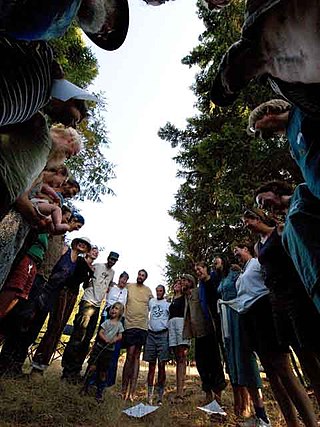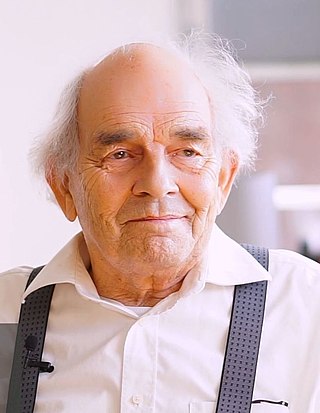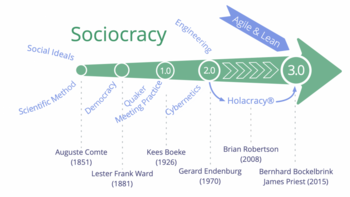
An ecovillage is a traditional or intentional community with the goal of becoming more socially, culturally, economically, and/or ecologically sustainable. An ecovillage strives to produce the least possible negative impact on the natural environment through intentional physical design and resident behavior choices. It is consciously designed through locally owned, participatory processes to regenerate and restore its social and natural environments. Most range from a population of 50 to 250 individuals, although some are smaller, and traditional ecovillages are often much larger. Larger ecovillages often exist as networks of smaller sub-communities. Some ecovillages have grown through like-minded individuals, families, or other small groups—who are not members, at least at the outset—settling on the ecovillage's periphery and participating de facto in the community. There are currently more than 10,000 ecovillages around the world.
Grassroots democracy is a tendency towards designing political processes that shift as much decision-making authority as practical to the organization's lowest geographic or social level of organization.

An organization or organisation, is an entity—such as a company, an institution, or an association—comprising one or more people and having a particular purpose.
Adhocracy is a flexible, adaptable and informal form of organization that is defined by a lack of formal structure that employs specialized multidisciplinary teams grouped by functions. It operates in an opposite fashion to a bureaucracy. The term was coined by Warren Bennis in his 1968 book The Temporary Society, later popularized in 1970 by Alvin Toffler in Future Shock, and has since become often used in the theory of management of organizations. The concept has been further developed by academics such as Henry Mintzberg.

Consensus decision-making or consensus process are group decision-making processes in which participants develop and decide on proposals with the goal of acceptance by all. The focus on establishing agreement of at least the majority or the supermajority and avoiding unproductive opinion differentiates consensus from unanimity, which requires all participants to support a decision. Consensus decision-making in a democracy is consensus democracy.
Governance is the process of making and enforcing decisions within an organization or society. It encompasses decision-making, rule-setting, and enforcement mechanisms to guide the functioning of an organization or society. Effective governance is essential for maintaining order, achieving objectives, and addressing the needs of the community or members within the organization. Furthermore, effective governance promotes transparency, fosters trust among stakeholders, and adapts to changing circumstances, ensuring the organization or society remains responsive and resilient in achieving its goals. It is the process of interactions through the laws, social norms, power or language as structured in communication of an organized society over a social system. It is done by the government of a state, by a market, or by a network. It is the process of choosing the right course among the actors involved in a collective problem that leads to the creation, reinforcement, or reproduction of acceptable conduct and social order". In lay terms, it could be described as the processes that exist in and between formal institutions.
A flat organization is an organizational structure with few or no levels of middle management between staff and executives. An organizational structure refers to the nature of the distribution of the units and positions within it, and also to the nature of the relationships among those units and positions. Tall and flat organizations differ based on how many levels of management are present in the organization and how much control managers are endowed with.
'Public administration theory Public administration theory encompasses various frameworks and concepts that guide the practice of managing public organizations and implementing public policies. Classical, neoclassical, and modern theories contribute to understanding the complexities of public administration.
Public participation, also known as citizen participation or patient and public involvement, is the inclusion of the public in the activities of any organization or project. Public participation is similar to but more inclusive than stakeholder engagement.

Diana Leafe Christian is an author, former editor of Communities magazine, and nationwide speaker and workshop presenter on starting new ecovillages, on sustainability, on building communities, and on governance by sociocracy. She lives in an off-grid homestead at Earthaven Ecovillage in the Blue Ridge Mountains of North Carolina, U.S. She has said that living in an intentional community "is the longest, most expensive, personal growth workshop you will ever take."
Governance is a broader concept than government and also includes the roles played by the community sector and the private sector in managing and planning countries, regions and cities. Collaborative governance involves the government, community and private sectors communicating with each other and working together to achieve more than any one sector could achieve on its own. Ansell and Gash (2008) have explored the conditions required for effective collaborative governance. They say "The ultimate goal is to develop a contingency approach of collaboration that can highlight conditions under which collaborative governance will be more or less effective as an approach to policy making and public management" Collaborative governance covers both the informal and formal relationships in problem solving and decision-making. Conventional government policy processes can be embedded in wider policy processes by facilitating collaboration between the public, private and community sectors. Collaborative Governance requires three things, namely: support; leadership; and a forum. The support identifies the policy problem to be fixed. The leadership gathers the sectors into a forum. Then, the members of the forum collaborate to develop policies, solutions and answers.
As developed by geolibertarian political economist Fred E. Foldvary, cellular democracy is a model of democracy based on multi-level bottom-up structures in either small neighborhood governmental districts or contractual communities.

Collaborative e-democracy refers to a hybrid democratic model combining elements of direct democracy, representative democracy, and e-democracy. This concept, first introduced at international academic conferences in 2009, offers a pathway for citizens to directly or indirectly engage in policymaking. Steven Brams and Peter Fishburn describe it as an "innovative way to engage citizens in the democratic process," that potentially makes government "more transparent, accountable, and responsive to the needs of the people."
A thesis circle involves a number of students and at least one professor, lecturer or instructor who collaborate in supervising and coaching final projects. This tool for supervising students working on their thesis, also known as "thesis rings", was developed in the 1990s at Maastricht University.

Gerard Endenburg is a Dutch entrepreneur, who developed the Sociocratic Circle Organisation Method (SCM), which is a decision-making method for governing and managing organizations and societies based on equivalence and draws inspiration from cybernetics. Endenburg was inspired by the idea of sociocracy of Kees Boeke.
Types of democracy refers to pluralism of governing structures such as governments and other constructs like workplaces, families, community associations, and so forth. Types of democracy can cluster around values. Some such types promote equal and direct participation in political acts. Others favor more indirect or procedural approaches to collective self-governance. Types of democracy can be found across time, space, and language. The foregoing examples are just a few of the thousands of refinements of, and variations on, the central notion of "democracy."not correct
Multistakeholder governance is a practice of governance that employs bringing multiple stakeholders together to participate in dialogue, decision making, and implementation of responses to jointly perceived problems. The principle behind such a structure is that if enough input is provided by multiple types of actors involved in a question, the eventual consensual decision gains more legitimacy, and can be more effectively implemented than a traditional state-based response. While the evolution of multistakeholder governance is occurring principally at the international level, public-private partnerships (PPPs) are domestic analogues.
Industrial democracy is an arrangement which involves workers making decisions, sharing responsibility and authority in the workplace. While in participative management organizational designs workers are listened to and take part in the decision-making process, in organizations employing industrial democracy they also have the final decisive power.
Holacracy is a method of decentralized management and organizational governance, which claims to distribute authority and decision-making through a holarchy of self-organizing teams rather than being vested in a management hierarchy. Holacracy has been adopted by for-profit and non-profit organizations in several countries. This can be seen as a greater movement within organisational design to cope with increasing complex social environments, that promises a greater degree of transparency, effectiveness and agility.

The Quaker business method or Quaker decision-making is a form of group decision-making and discernment used by Quakers, or 'members of the Religious Society of Friends', to organise their religious affairs. It is primarily carried out in meetings for worship for business, which are regular gatherings where minutes are drafted, to record collective decisions.







